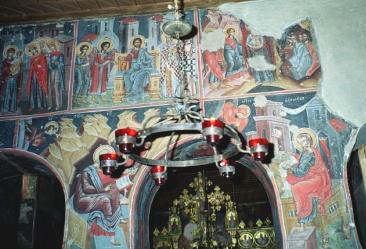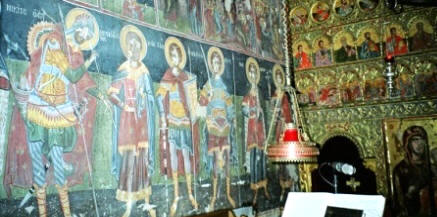
CONCENTRATIVE TABLE OF MURALS IN
METEORA
The murals in the monasteries of Meteora are appertained to
three periods.
• The first period: 1500 --- 1573
• The second period: 1637 --- 1692
• The third period: 1718 --- 1784
During the first period, the majority of the painters who worked
in Meteora, came from elsewhere.
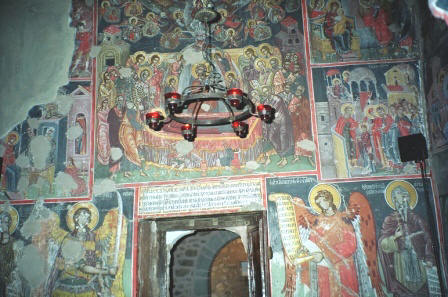
In Thessaly, in the first 73 years of the first period and in
the years of the Ottoman rule, an intense artistic bustle has
been observed in Meteora.
In the Holy Monastery of the Great Meteoron (Transfiguration),
the murals of the sanctuary were painted in 1484. The Katholikon
was painted in 1552 under the supervision of the Abbot Simeon.
Today, the murals are well cleaned and preserved.
The
portable icons of the monastery are exquisitely interesting due
to their antiqueness. Some of these are: The Virgin Holding
Jesus, Saint Nicholas, the birth of Christ, the Transfiguration
and the Three Hierarchs. The set of 12 icons of the 16th
century, depicting the saints of the Menologion and the icons of
the Twelve Great Feasts (Dodekaorto) are also remarkable.
The first
Cretan to paint murals in Meteora, and specifically at the Holy
Monastery of St. Nicolas Anapafsas in 1527, was the monk
Theophanis Strelitzas (or Bathas).
Equipped
with loyalty and talent, he paints the murals of the Monastery.
The murals are a characteristic
instance of the Cretan school, distinguished for their kindness
and liveliness, their soft and bright tones and generally their
high quality and perfection of design and color of the figures,
which follow the Byzantine tradition and are influenced by the
Western standards.
The
Cretan way of painting was favoured by
the upper hierarchy of the church and had been fostered as an
official version of the Orthodox Helladic art in many areas,
especially in monasteries and abroad.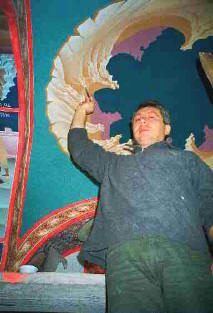
Of all the murals painted by Theophanis,
the most distinctive is the one that depicts a scene in which
Adam is in heaven. The vivid
colors and the entire synthesis are enchanting, rendering it the
first notable secular mural. The monastery was renovated
by the 7th Inspectorate of Antiquities and there has
been a restoration of the murals, which regained their previous
brilliance.
The murals in the Monastery of St.
Stephen were painted under the Abbot Metrophanes and are
presently well maintained and constitute a post-Byzantine set of
murals. The renovation of the Dormition of Theotokos was carried
out by the painter priest Nicholas in 1501.
The
Church of Saint Charalambos was painted by the painter Vlassios
Tsotsonis, following the standards of other Katholika and the
traditions of monasteries in Meteora.
In 1548,
the Theban painter Franc Katelano gets to Meteora in order to
paint the main church of the Monastery of Varlaam. His murals
stand out for their narrative detail, the analysis of the
historical events and their intense realism. He is influenced by
the Italian art, which is more vibrant and the painting of the
church ends in 1548.
The
Theban painters George and Franc Kontaris follow, who fresco the
narthex of the Holy Monastery of Varlaam in 1566.
At the monastery of Rousanou, the murals are one of the most
important and brilliant sets of the post-Byzantine era; they
belong to the Cretan school and to Theofanis’ pupil George
(according to specialists).
During
the second period, in 1637, the frescoes of the Kalambakiotis
painter John are typical of all the post-Byzantine icons.
The monk Nicodemus painted the chapels of
Saint John Prodromos: the monastery of the Holy Trinity and the
Monastery of the Transfiguration in 1682. The narthex was
frescoed in 1692 by three painters: Rizos, John and Athanasios.
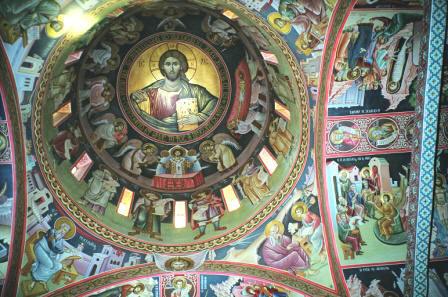
During the third period, in 1741, the murals in the nave of the
Holy Monastery of the Holy Trinity were completed, by the priest
Anthony and his brother Nicholas, who kept the tradition of good
post-Byzantine painting alive.
In 1748, the painters Dim. Zoukis and his
assistant George from Kalarytes undertook the painting of the
Monastery of the Ypapanti.
In 1782
the monk Parthenios designed Meteora and the surrounding area
into a copperplate.
A remarkable bloom is evident in the
monasteries of Meteora in the mid-15th-16th century. A proof of
this boom of the meteorite monasticism is the maintenance and
painting of the churches, which reveal a ritualistic beauty.
At the Meteora monasteries, in the past
three decades, castles and religious icons have been restored
and churches have been preserved and painted. Today, the monks
and the nuns have started copying thousands of manuscripts.
CONCENTRATIVE TABLE OF MURALS IN METEORA
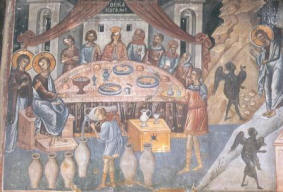
1. The Holy Monastery of the Great
Meteoron.
1484:
The Holy Monastery of the
Transfiguration was painted.
1552: The Katholikon of the
monastery was frescoed by an unknown artist.
